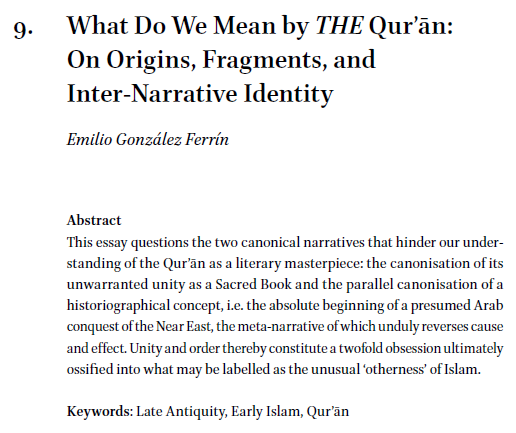
An interesting orthographic feature of early Quranic vocalisation is that it differentiates word-initial ʾa from ʾā by the position of the fatḥah. For ʾa the fatḥah is to the RIGHT of the ʾalif and for ʾā it is to the LEFT.
ʾahli l-kitābi
ʾāmanū

ʾahli l-kitābi
ʾāmanū


This is a bit puzzling, because conceptually, Arab grammarians think of ʾāmanū to consist of hamzah followed by fatḥah and then ʾalif. So it is rather odd that the dot that denotes the hamzah comes after the ʾalif.
Al-Dānī in his muḥkam, a description of vocalisation agrees:
Al-Dānī in his muḥkam, a description of vocalisation agrees:
"All the dotters of ʿIrāq disagree with the people of Medina and others (notably Andalus and Maghreb) on the word-initial hamzah carrying a fatḥah which has an ʾalif after it within a single word, for example: ʾāmana, ʾādama and ʾāzara. They place it after the ʾalif. 

There is no basis for this, since (the hamzah) is pronounced before the ʾalif, preceding it. So how could it be placed behind it, while the fatḥah that follows it is connected to the dot?!"
Al-Dānī's horror of this bizarre practice is palpable.
Al-Dānī's horror of this bizarre practice is palpable.
And indeed if we look at Maghrebi Qurans from a bit after his time, we see see the practice that he endorses for the Maghreb, with the yellow hamzah dot at the height of the fatḥah *before* the ʾalif, carrying a fatḥah
ʾātaynāhum(u)
ʾāyātinā
wa-ʾāmana



ʾātaynāhum(u)
ʾāyātinā
wa-ʾāmana




However, the muḥkam is ostensibly talking about *dotting* and placing a red DOT fatḥah on top of the yellow dot of the hamzah, rather than the red strokes.
One could chalk that up to an imprecision of description in the case of the fatḥah and kasrah...
One could chalk that up to an imprecision of description in the case of the fatḥah and kasrah...
But in these discussions, al-Dānī is explicit that the ḍammah is not the shape of a miniature wāw above the letter (which it is in maghrebi manuscripts like these), but a red dot that stands on the baseline to the left of the letter, which manuscripts like these do not have.
However, if we actually go back to a time that the Maghreb region still produced manuscripts with red dots for the vowels, rather than red versions of the modern signs, we do not actually find the practice described by al-Dānī.
The Palermo Quran (dated 372 AH/982-3 AD) is an absolute masterpiece of the 'New Style' of quranic script. Written in the popular reading of Warš ʿan Nāfiʿ, it displays many of the subtle orthography features that al-Dānī describes in detail. 

Thus it uses the red stroke to mark the ʾalif al-waṣl, with placement at the top denoting preceding vowel is fatḥah, below if the preceding vowel is kasrah, and in the middle to if the preceding vowel is ḍammah.
wa-r-rukkaʿi s-suǧūdi
yudḫilu llādīna

wa-r-rukkaʿi s-suǧūdi
yudḫilu llādīna


It also uses the red line and a blue dot to denote an elided hamzah:
al-ʾabhār > alabhār
There is also uses of a set of semi-circles oriented in different ways to denoted long consonants followed by a vowels (visible with the assimilated definite article in the previous tweet)
al-ʾabhār > alabhār
There is also uses of a set of semi-circles oriented in different ways to denoted long consonants followed by a vowels (visible with the assimilated definite article in the previous tweet)

These are all practices that al-Dānī understood fully well, and described accurately and in detail, even though not all of these practices make it into the later Maghrebi manuscripts. He seems to have a clear memory or understanding of documents such as these.
However, when it comes to the spelling of the hamzah, his description is simply not in line with what we see. To al-Dānī the yellow dot of the hamzah should be accompanied by a red dot for the vowel. We never see this. The yellow dot does double duty:
ʾinna
ʾan
etc.

ʾinna
ʾan
etc.


But the most striking thing is, that al-Dānī's so despised "Iraqi" practice of placing the yellow dot of ʾā AFTER the alif is found in such manuscripts as well!
ʾāmanū
To my knowledge, the system as he describes it does not appears in manuscripts at all.
ʾāmanū
To my knowledge, the system as he describes it does not appears in manuscripts at all.

So what's going on? Was he being prescriptivist? Or was he mostly familiar with the 'modern' vocalisation with normal signs for the vowels, and he simply extrapolated what he knew from those, and applied them to the dotting system without checking?
Or are we missing a crucial missing link between the Palermo Quran (10th century) and the more 'modern' Maghrebi Qurans of the 12th century and later (al-Dānī himself was an 11th century scholar)?
Questions which, as of yet, do not have a clear answer.
Questions which, as of yet, do not have a clear answer.

If you enjoyed this thread and want me to do more of it, please consider buying me a coffee.
ko-fi.com/phdnix.
If you want to support me in a more integral way, you can become a patron on Patreon!
patreon.com/PhDniX
ko-fi.com/phdnix.
If you want to support me in a more integral way, you can become a patron on Patreon!
patreon.com/PhDniX
• • •
Missing some Tweet in this thread? You can try to
force a refresh














